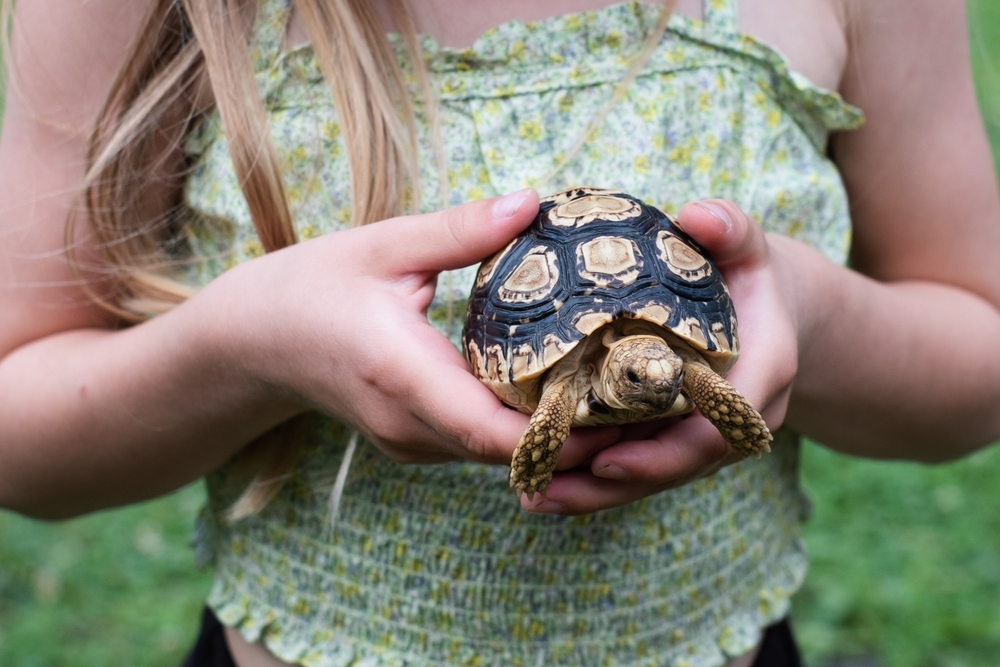
Creating a comfortable and stimulating environment for your Leopard tortoise is crucial for its health and well-being. Leopard tortoises, known for their striking appearance and long lifespan, require specific conditions to thrive. In this guide, we’ll explore how the Perfect habitat setup for leopard tortoises, ensuring they have everything they need to live a happy and healthy life.
Designing the Ideal Habitat
When setting up a habitat for your Leopard tortoise, several key factors must be considered to mimic their natural environment as closely as possible:
- Enclosure Size and Type: Leopard tortoises are known for their large size and need ample space to roam. A spacious enclosure is essential, especially for adults. Outdoor enclosures are often the best choice, as they provide natural sunlight and ample space. The enclosure should be large enough to allow for natural behaviors such as burrowing and grazing. If indoor housing is necessary, ensure the enclosure is as large as possible, with a minimum size of 4×8 feet for a single tortoise.
- Substrate: The substrate in your tortoise’s enclosure should allow for natural digging behavior and be comfortable for their feet. A mix of soil and sand or a specialized tortoise substrate can work well. Avoid using materials like pine or cedar shavings, which can be harmful to tortoises.
- Temperature and Lighting: Leopard tortoises require a temperature gradient to regulate their body temperature. In an outdoor setup, they can benefit from natural sunlight, but indoor setups need specific temperature controls. Provide a basking area with temperatures between 85 and 95 degrees Fahrenheit and a cooler area around 70 degrees Fahrenheit. Use a UVB light source to mimic natural sunlight, which is crucial for their calcium metabolism and overall health.
- Humidity and Water: While Leopard tortoises are adapted to arid environments, they still require proper hydration. Provide a shallow water dish for drinking and soaking, and ensure the humidity levels in the enclosure are adequate to prevent dehydration. Regular soaks in a shallow dish of water can help maintain proper hydration and aid in digestion.
Enrichment and Habitat Features
Enrichment is essential for the mental and physical health of your Leopard tortoise. Here are some tips to create a stimulating environment:
- Natural Elements: Incorporate natural elements such as rocks, logs, and plants into the enclosure. These items provide hiding spots and encourage natural behaviors. Ensure that any plants used are non-toxic and safe for tortoises.
- Burrowing Opportunities: Leopard tortoises in the wild often dig burrows to create shelter. Providing areas in the enclosure where they can dig will help mimic their natural environment and keep them engaged.
- Diet and Feeding Areas: Create designated feeding areas within the enclosure. Leopard tortoises thrive on a diet of grasses, leafy greens, and occasional vegetables. Ensure they have access to fresh food and clean water daily.
Health and Safety Considerations
Maintaining the health and safety of your Leopard tortoise involves regular monitoring and care:
- Regular Cleaning: Clean the enclosure regularly to prevent the buildup of waste and potential health hazards. Replace the substrate as needed and ensure that the water dish is kept clean.
- Health Monitoring: Keep an eye on your tortoise’s behavior, shell condition, and appetite. Any significant changes in behavior or health should be addressed promptly with a veterinarian experienced in reptile care.
- Protection from Predators: If you have an outdoor enclosure, ensure it is secure from potential predators such as dogs or wild animals. The enclosure should be well-fenced and free from gaps or weaknesses.
Conclusion
Creating the perfect home for your Leopard tortoise involves careful planning and attention to detail. By providing a spacious and well-designed enclosure, appropriate temperature and lighting, and enrichment opportunities, you can ensure that your tortoise has a healthy and stimulating environment. Regular maintenance and monitoring are key to keeping your tortoise happy and thriving. With the right setup and care, your Leopard tortoise will enjoy a long, healthy life as a cherished member of your family.






